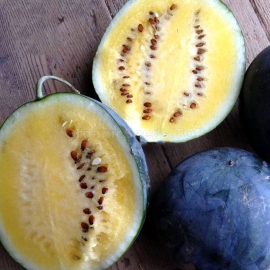


«Janosik» - Organic Watermelon Seeds
1.14 €
Janosik is a highly recommended, yellow-flesh Polish breeding. It appears dark green skinned, nearly seedless and 4-5 kg (8,8-11 lbs) in weight. It`s yellow pulp contrasts perfectly other known pinkish and orange varites.
-
Heirloom watermelon «Janosik»
Janosik is a highly recommended, yellow-flesh Polish breeding. It appears dark green skinned, nearly seedless and 4-5 kg (8,8-11 lbs) in weight.
It`s yellow pulp contrasts perfectly other known pinkish and orange varites. Its convinient size is easy to manage in the kitchen. It loves sunny and very warm spot, just as every melon.
Germination
In cool climates, watermelon seeds should be started indoors, but no sooner than a month before transplanting; plant three seeds per peat pot, 1/4" deep. Provide heat to keep the soil at least 80-85 degrees F. Cut off all but the strongest seedling as soon as true leaves appear, and transplant about a week after frost; put two or three plants in each hill with a 6-8' space in all directions.
Gardeners in warm climates will be able to direct sow watermelons as soon as the soil temperature reaches at least 75 degrees F, planting six seeds per hill with 6-8' of space in all directions. Thin to the strongest two or three plants as soon as the seedlings appear. Watermelons should be planted in full sun and rich, loose soil. Young seedlings may benefit from black plastic to warm up the soil.
Growing Seeds
As soon as the vines begin to develop, apply a thick layer of mulch to control weeds and protect the melons from soil contact. Keep the soil moist until the fruit begins to grow, then water only if the soil dries out completely. Watch out for insect pests, which can be a problem. Charleston Grey is resistant to anthracnose and fusarium wilt.
Harvesting
Gardeners use many different methods of testing whether their watermelons are ripe, but knowing the approximate mature size of the melon helps to determine when it is nearing ripeness. One test is to knock on the watermelon with your knuckles, listening for a dull thump rather than a hollow ring. Another method is to check the underside of the melon where it rests on the ground; the skin should be a rich yellow. Also, the curling tendril closest to the stem of the melon often indicates ripeness when it begins to turn brown. Watermelons usually keep for several weeks in a cool place.
